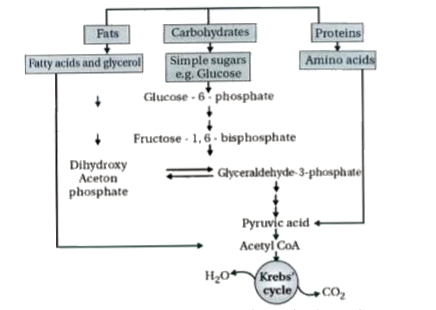Discuss "The respiratory pathway is an amphibolic pathway "Solution in Gujrati
Glucose is the favoured substrate for respiration.
All carbohydrates are usually first converted into glucose before they are used for respiration.
Other substrates can also be respired, but then they do not enter the respiratory pathway at the first step .

As per shown in figure, Fats would need to be broken down into glycerol and fatty acids first.
If fatty acids were to be respired they would first be degraded to acetyl CoA and enter the pathway.
Glycerol would enter the pathway after being converted to PGAL.
The protein would be degraded by proteases ad the individual amino acids depending on their would enter the pathway at some stage within the Krebs. cycle or even as pyruvate of acetyl CoA .
Since respiration breakdown of substrates, the respiratory process has traditionally been considered a catabolic process and the respiratory pathway as a catabolic pathway.
Hence fatty acids would be broken down to acetyl CoA before entering the respiratory pathway when it is used as substate.
These vary compounds that would be withdrawn from the respiratory pathway for the synthesis of the said substrates.
When the organism needs to synthesize fatty acid acetyl CoA would be withdrawn from the respiratory pathway for it
Hence, the respiratory pathway comes into the picture both during breakdown and synthesis or fatty acids.
Similarly during breakdown and synthesis of protein too, respiratory intermediates for the link.
Breaking down processes within the living organism is catabolism and synthesis is anabolism .
Because the respiratory pathway is involved in both anabolism and catabolism.
It would hence be better to consider the respiratory pathway an an amphibolic pathway rather then as a catabolic one.
Topper's Solved these Questions
- RESPIRATION IN PLANTSBOOK - KUMAR PRAKASHANCHAPTER - RESPIRATION IN PLANTSEXERCISE - Section - B (Difference /Scientific Reasons )
7 Videos
- RESPIRATION IN PLANTSBOOK - KUMAR PRAKASHANCHAPTER - RESPIRATION IN PLANTSEXERCISE - Section - C (Location-Function /Full Name / Formulas)
26 Videos
- PLANT KINGDOMBOOK - KUMAR PRAKASHANCHAPTER - PLANT KINGDOMEXERCISE - OBJECTIVE SECTION (FILL IN THE BLANKS)
9 Videos
- SAMPLE QUESTION PAPER FOR ANNUAL EXAMBOOK - KUMAR PRAKASHANCHAPTER - SAMPLE QUESTION PAPER FOR ANNUAL EXAMEXERCISE - SECTION - D
2 Videos
Similar Questions
Aerobic respiration and Anaerobic respiration
View SolutionWhat are called stomata ?
View SolutionAsexual reproduction is by .......... produced in zoosporangia in chlorophyceae.
View SolutionExplain Hatch-Slack pathway.
View SolutionDiscuss “The respiratory pathway is an amphibolic pathway.”
View SolutionDiscuss “The respiratory pathway is an amphibolic pathway.”
View SolutionRespiratory pathway is referred to as an amphibolic pathway ?
View SolutionDiscuss “The respiratory pathway is an amphibolic pathway.â€
View SolutionDiscuss 'The respiratory pathway is an amphibolic pathway."
View SolutionRespiratory Balance Sheet | Amphibolic Pathway | Respiratory Quotient
View SolutionDiscuss “The respiratory pathway is an amphibolic pathway.”
View SolutionAmphibolic pathway|Respiratory quotient
View SolutionDiscuss "The respiratory pathway is an amphibolic pathway "
View SolutionDiscuss “The respiratory pathway is an amphibolic pathway.”
View SolutionDiscuss “The respiratory pathway is an amphibolic pathway.”
View SolutionDiscuss ‘The respiratory pathway is an amphibolic pathway.”
View Solution